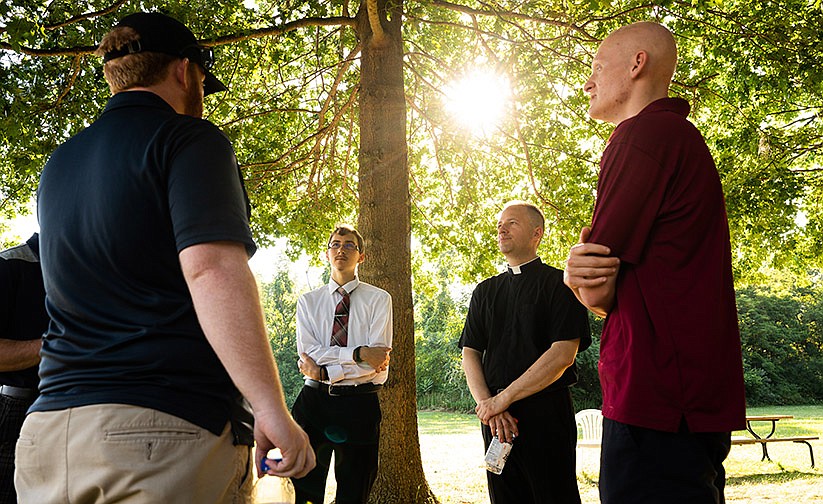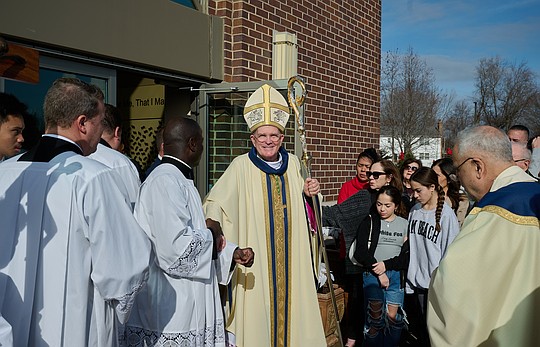Trusted relationships with priests key to fostering vocations, study says
March 13, 2023 at 11:58 p.m.

OSV News – A new study cites trusted relationships with parish priests as a deciding factor in cultivating vocations and reducing the priest-to-parishioner ratio as essential for making such encounters possible.
The 2023 "State of Priestly Vocations in the United States" by Texas-based Vocation Ministry concludes that "the overall role of priests in fostering vocations is significant," with "around 70% of those ordained" reporting that they were invited by a priest to consider the calling.
"We know the priest is the number one factor for a young man saying 'yes' to the priesthood," Vocation Ministry founder Rhonda Gruenewald told OSV News.
But as ordination numbers decline while many parishes close or merge, priests are becoming responsible for a greater number of parishioners, Gruenewald said. With increased administrative and pastoral responsibilities, clergy often have little time and energy to mentor teens and young men who might be interested in religious life.
"If that (priest-to-parishioner) number is lower, then priests can create relationships that foster vocations," said Gruenewald, whose report draws on data from the Official Catholic Directory along with input from vocation directors and seminarians from around the country.
According to the Center for Applied Research in the Apostolate at Georgetown University (CARA), in 2022 there were 34,344 priests (24,110 diocesan, 10,234 religious) and 452 priestly ordinations in the U.S., serving 16,429 parishes and 66.5 million "parish-connected" Catholics. Just 66% of the diocesan priests were in active ministry, with an average of one active diocesan priest per parish.
The Vocations Ministry study grouped the nation's Catholic dioceses into four tiers based on the size of their Catholic population, and then calculated how many replacement priests, seminarians and ordinations are needed in each diocese for pastoral viability, based on current conditions.
[[In-content Ad]]
Gruenewald, who has conducted training sessions for thousands of priests, catechists, Catholic school educators and laity in more than 50 dioceses, concluded that the 2021 vocation data showed only 33 dioceses ordained enough men to satisfy a "base need ordination rate," while 17 were meeting their "base need seminarian rate." Another 42 dioceses had no ordinations during that period.
She admits that the data "might be difficult for some to digest."
CARA executive director Jesuit Father Thomas Gaunt, who reviewed the Vocations Ministry report, told OSV News the study did not account for shifts in the Catholic population across the U.S., which have led to a "massive movement of Catholics out of the cities and into the suburbs, and from the Northeast and Midwest to the South and West" of the nation.
However, Father Gaunt noted the report was correct in its "overall contention on targeting the importance of relationships in encouraging vocations."
Of the four population tiers in the Vocations Ministry report, the highest-performing group was that with the lowest population and the lowest priest-to-parishioner ratio. Dioceses in this tier – which included Lincoln, Nebraska; Tulsa, Oklahoma; and Reno, Nevada – typically ordain six times as many men as do the nation's most populous dioceses.
Gruenewald stressed that Catholics have plenty of options for countering the declines in priestly vocations – such as regular prayer, education about vocations and how to foster them, affirmation of current priests and seminarians, and youth ministry.
"Priests and parishioners need to find those pockets where young people are and bring the vocations message to them," she told OSV News. "Instead of throwing our hands up and saying, 'Oh well,' we need to be intentional and strategic. Vocations can happen if you believe. Let's get to work."
Gina Christian is a national reporter for OSV News. Follow her on Twitter at @GinaJesseReina.
Related Stories
Friday, January 02, 2026
E-Editions
Events
OSV News – A new study cites trusted relationships with parish priests as a deciding factor in cultivating vocations and reducing the priest-to-parishioner ratio as essential for making such encounters possible.
The 2023 "State of Priestly Vocations in the United States" by Texas-based Vocation Ministry concludes that "the overall role of priests in fostering vocations is significant," with "around 70% of those ordained" reporting that they were invited by a priest to consider the calling.
"We know the priest is the number one factor for a young man saying 'yes' to the priesthood," Vocation Ministry founder Rhonda Gruenewald told OSV News.
But as ordination numbers decline while many parishes close or merge, priests are becoming responsible for a greater number of parishioners, Gruenewald said. With increased administrative and pastoral responsibilities, clergy often have little time and energy to mentor teens and young men who might be interested in religious life.
"If that (priest-to-parishioner) number is lower, then priests can create relationships that foster vocations," said Gruenewald, whose report draws on data from the Official Catholic Directory along with input from vocation directors and seminarians from around the country.
According to the Center for Applied Research in the Apostolate at Georgetown University (CARA), in 2022 there were 34,344 priests (24,110 diocesan, 10,234 religious) and 452 priestly ordinations in the U.S., serving 16,429 parishes and 66.5 million "parish-connected" Catholics. Just 66% of the diocesan priests were in active ministry, with an average of one active diocesan priest per parish.
The Vocations Ministry study grouped the nation's Catholic dioceses into four tiers based on the size of their Catholic population, and then calculated how many replacement priests, seminarians and ordinations are needed in each diocese for pastoral viability, based on current conditions.
[[In-content Ad]]
Gruenewald, who has conducted training sessions for thousands of priests, catechists, Catholic school educators and laity in more than 50 dioceses, concluded that the 2021 vocation data showed only 33 dioceses ordained enough men to satisfy a "base need ordination rate," while 17 were meeting their "base need seminarian rate." Another 42 dioceses had no ordinations during that period.
She admits that the data "might be difficult for some to digest."
CARA executive director Jesuit Father Thomas Gaunt, who reviewed the Vocations Ministry report, told OSV News the study did not account for shifts in the Catholic population across the U.S., which have led to a "massive movement of Catholics out of the cities and into the suburbs, and from the Northeast and Midwest to the South and West" of the nation.
However, Father Gaunt noted the report was correct in its "overall contention on targeting the importance of relationships in encouraging vocations."
Of the four population tiers in the Vocations Ministry report, the highest-performing group was that with the lowest population and the lowest priest-to-parishioner ratio. Dioceses in this tier – which included Lincoln, Nebraska; Tulsa, Oklahoma; and Reno, Nevada – typically ordain six times as many men as do the nation's most populous dioceses.
Gruenewald stressed that Catholics have plenty of options for countering the declines in priestly vocations – such as regular prayer, education about vocations and how to foster them, affirmation of current priests and seminarians, and youth ministry.
"Priests and parishioners need to find those pockets where young people are and bring the vocations message to them," she told OSV News. "Instead of throwing our hands up and saying, 'Oh well,' we need to be intentional and strategic. Vocations can happen if you believe. Let's get to work."
Gina Christian is a national reporter for OSV News. Follow her on Twitter at @GinaJesseReina.










